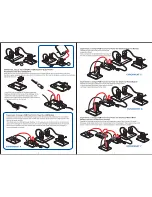
1. The water levels do not drop when the gas outlet tubes on both sides of the fuel cell are unplugged.
Solution:
Check whether the holes on the wall of the inner container are blocked. If so, turn the inner
container until water enters the holes and fills up the inner container.
2. The electrolyzer does not produce hydrogen and/or oxygen.
Solution 1:
Check whether the wires are appropriately connected, and whether there are any loose
connections. The fuel cell could be completely destroyed if the red wire of the battery pack is
connected to the black jack of the fuel cell.
Solution 2:
Replace the old batteries with new one in the battery pack.
3. The load cannot work while there is hydrogen left in the inner container.
Solution:
Push the green purging valve to release tiny amount of hydrogen. You can then observe the load
working well again.
4. The water electrolysis process slows down.
Solution:
Inject water to the oxygen side of the fuel cell by using the syringe and wait for about 3 minutes
before using the electrolyzer again.
5. No hydrogen is produced using the windturbine outdoors.
Solution:
If the wind speed is not sufficient electricity will not be created. Use a common desk fan with faster
wind speed to perform the electrolysis using the electrolyzer, or conduct the experiment under
stronger wind conditions.
6. If the fuel cell and/or electrolyzer becomes flooded with water
Solution 1:
Use the syringe to clear the water out of the fuel cell.
Solution 2:
Use the hair drier to blow hot air towards the fuel cell and the nozzles on each side. Make sure you
blow warm air towards the fuel cell.
7. The fuel cell can not generate electricity while there is hydrogen still left in the hydrogen container.
Solution 1:
Push the purging valve to release remaining amounts of hydrogen.
Solution 2:
Use the syringe to clear the water out of the fuel cell.
RENEWABLE ENERGY SCIENCE EDUCATION KIT
TECHNICAL SUPPORT
www.fuelcellstore.com





